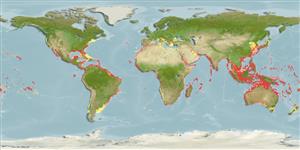>
Carangiformes (Jacks) >
Echeneidae (Remoras)
Etymology: Echeneis: Greek, echein = to hold + Greek, nays = ship; remora, suckling fish; 1774 (Ref. 45335).
More on author: Linnaeus.
Environment: milieu / climate zone / depth range / distribution range
Ecologie
marien; brak water rifbewoner; diepte 1 - 85 m (Ref. 86942). Subtropical; 45°N - 45°S, 180°W - 180°E
Circumtropical.
Grootte / Gewicht / Leeftijd
Maturity: Lm ? range ? - ? cm
Max length : 110 cm TL mannelijk / geslacht onbekend; (Ref. 9710); common length : 66.0 cm SL mannelijk / geslacht onbekend; (Ref. 10970); max. gepubliceerd gewicht: 2.3 kg (Ref. 40637)
Dorsale stekels (totaal): 0; Dorsale zachte stralen (totaal): 32-42; Anale stekels 0; Anale zachte stralen: 29 - 41.
Most abundant remora in warm waters (Ref. 4389). Occurs near as well as far from the coast (Ref. 5217). Often found free-swimming in shallow inshore areas and around coral reefs (Ref. 26938). Attaches temporarily to a variety of hosts including sharks, rays, large bony fishes or sea turtles, whales, dolphins and also to ships. May follow divers (Ref. 9710); reported to attach itself to a diver's leg (Ref. 57809). Feeds on small fishes, bits of its host's prey and host's parasites (Ref. 26938). Juveniles occasionally act as reef station-based cleaners, where they service parrotfishes (Ref. 40095). Sometimes used by natives to aid in fishing; a line is tied to the caudal peduncle of the remora and then is released; upon attaching to another fish, the remora and its host are hauled in by the fisher (Ref. 9682).
Levenscyclus en paargedrag
Maturiteit | Voortplanting | Paaien | Eieren | Fecunditeit | Larven
Paxton, J.R., D.F. Hoese, G.R. Allen and J.E. Hanley, 1989. Pisces. Petromyzontidae to Carangidae. Zoological Catalogue of Australia, Vol. 7. Australian Government Publishing Service, Canberra, 665 p. (Ref. 7300)
Status op de Rode Lijst van het IUCN (Ref. 130435)
Gevaar voor de mens
Harmless
Gebruik door de mens
Visserij: van minder commercieel belang; sportvis: ja; Aquarium: Commercieel
Tools
Speciale rapporten
Download XML
Internetbronnen
Estimates based on models
Preferred temperature (Ref.
123201): 18.3 - 28.6, mean 27.2 °C (based on 566 cells).
Fylogenetische diversiteitsindex (Ref.
82804): PD
50 = 0.7539 [Uniqueness, from 0.5 = low to 2.0 = high].
Bayesian length-weight: a=0.00263 (0.00112 - 0.00620), b=3.17 (2.96 - 3.38), in cm total length, based on LWR estimates for this (Sub)family-body shape (Ref.
93245).
Trofisch niveau (Ref.
69278): 3.7 ±0.3 se; based on diet studies.
Weerstandsvermogen (Ref.
120179): Gemiddeld, minimale populatieverdubbelingstijd 1,4-4,4 jaar (Assuming Fec < 10,000).
Fishing Vulnerability (Ref.
59153): High to very high vulnerability (66 of 100).
Nutrients (Ref.
124155): Calcium = 22.5 [10.7, 37.1] mg/100g; Iron = 0.59 [0.32, 0.99] mg/100g; Protein = 19.8 [18.7, 20.8] %; Omega3 = 0.128 [0.068, 0.250] g/100g; Selenium = 28.3 [13.0, 54.4] μg/100g; VitaminA = 25.8 [8.3, 87.1] μg/100g; Zinc = 0.702 [0.456, 1.085] mg/100g (wet weight);
